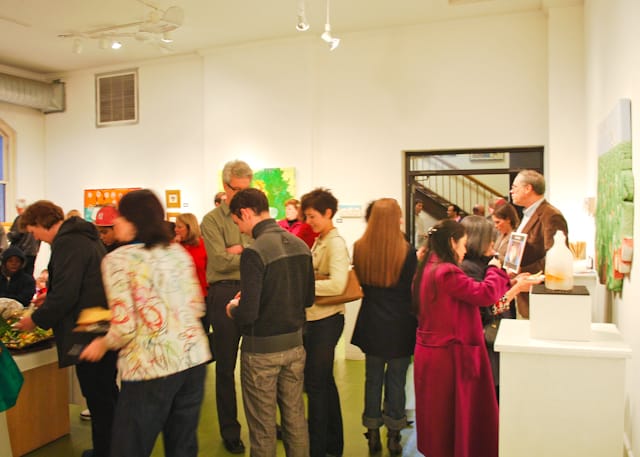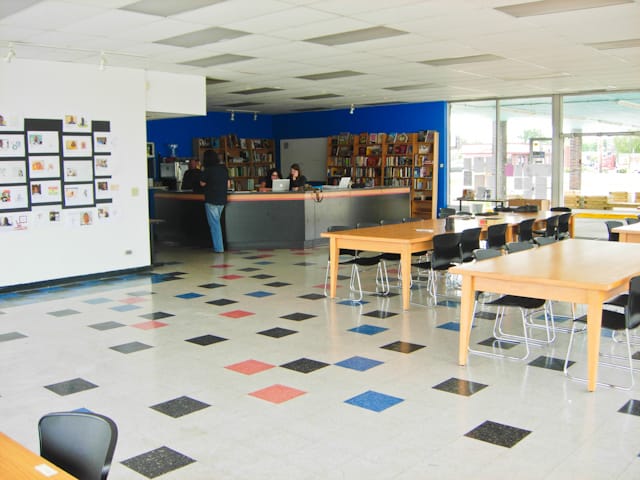Getting to Know the Indianapolis Art Scene
Indianapolis, Indiana, does not often come to mind when thinking about art scenes, especially for those who live in global hubs like New York City, London, Berlin and Los Angeles. People in those cities tend to believe that next to nothing occurs outside of them. Having moved from Indiana to Brookly

Indianapolis, Indiana, does not often come to mind when thinking about art scenes, especially for those who live in global hubs like New York City, London, Berlin and Los Angeles. People in those cities tend to believe that next to nothing occurs outside of them. Having moved from Indiana to Brooklyn two years ago (I’m from Richmond, where Indianapolis is referred to as “the big city”), I wanted to explore Indianapolis’s art scene with fresh eyes.
First, a little background about the state capital. Indianapolis is the 12th largest city in the US, with almost 830,000 people. Spread out over 372 square miles, this makes it roughly half the population of Manhattan on ten times the land. Formerly a heavily industrial city, Indianapolis has managed to adapt and transform into a tourist locale. It has the most public artworks and monuments of any city in the US besides Washington, DC, and it’s now a hub for all manner of sports fans, with football (Colts), basketball (Pacers), the Indianapolis 500 and, of course, NASCAR.
Today, Indianapolis is known more as a sports city than as an arts city, and rightly so. People flock from all over to watch games, and when the Colts are playing, much of the city turns white and blue. But what about the arts? What is there to see and do?

The Indianapolis Museum of Art (IMA) is the #1 destination for art in Indiana. The IMA, which offers free admission except for occasional special exhibitions, underwent a $74 million expansion in 2005, making it a huge museum. It also recently opened 100 Acres, the largest art and nature park dedicated to commissioning contemporary installations in the United States, and represented the country in last summer’s Venice Biennale with works by Allora & Calzadilla. The IMA has put Indianapolis on the map as a destination for the arts. Unfortunately, it’s also most likely the only arts institution in Indianapolis you’ll recognize.

A newer addition to the scene is the Indianapolis Museum of Contemporary Art, iMOCA, which has steadily been growing in size and stature since its beginnings as a pop-up gallery in 2001. There’s also the Herron School of Art and Design at Indiana University–Purdue University, which turns out some quality artists, although it’s more focused on crafts rather than conceptual or contemporary art. The Harrison Center for the Arts, which includes multiple galleries and studios, does a lot of community outreach, while the Murphy Fine Arts Center houses various galleries, artist studios and creative businesses. And … that’s about it. Indianapolis has a very small and extremely interwoven arts community.
Because of the modest size of the community, the city has a lack of art buyers, an issue I talked about with Jeremy Efroymson, the former director of iMOCA and a curator, founder or board member of many cultural institutions. He is also an artist and involved with his family’s Efroymson Family Fund. At one point in our discussion, which covered his work in the arts as both a philanthropist and a creative professional, he joked about Indianapolis’s struggling market. “I thought it was customary that if you come to every opening and drink the wine, you would have to eventually buy some art,” he said.
Efroymson has extensive experience as a grassroots organizer, with deep pockets for local arts organizations. “Since the fund was established in 1998, it has awarded more than $60 million to not-for-profit organizations in central Indiana and beyond,” he said.

When asked what his favorite contribution to the arts has been, Efroymson quickly responded with the Efroymson Contemporary Arts Fellowship, which gives $20,000 to five contemporary artists in Indiana and Illinois every year. The fund is crucial to convincing creatives to stay in Indiana. “Indianapolis is a place where anyone can have an immediate impact in the arts,” he said, and building a strong arts community there seems to be Efroymson’s chosen impact.
“In Indiana, the real need is to get art into schools all the way back to kindergarten,” he added. “If kids don’t learn about art from a young age, how are they going to decipher it in a museum when they are 21?”

This is where Joanna Taft’s work with the Harrison Center for the Arts, City Gallery and Herron High School comes into view. When I was living in Indianapolis and my sights were set on moving to New York City to become a professional artist, I completely missed the importance of Taft’s work. I was perturbed by the wide range of artists put under one roof for an opening night I attended, arrogantly thinking that an opening of my work should never coincide with art by high school students down the hall. Taft, however, believes in collapsing these walls between various creative communities to help foster new dialogues and enrich Indianapolis. She often organizes theme shows to get people in the door who aren’t necessarily art enthusiasts; for instance, FoodCon, an unconventional food convention, housed several galleries dedicated to art that explores food and a gymnasium packed with a farmers market selling the local organic harvest.

Taft believes that raising a new generation of creatives is crucial to future of the Indianapolis. She helped create Herron High School with the goal of providing a creative curriculum to a diverse student body. “They will grow up to be our voters, scientists, artists, moms, volunteers, doctors, philanthropists,” she told me. “It is what Indianapolis needs to be a world class city.” She also started a cultural entrepreneurship program geared toward high school and college students.
Taft is just getting into her newest project, City Gallery, which acts as a meeting place for local residents and creatives who need help finding affordable housing, and who want to work together to engage their neighborhoods. This type of informal space, dedicated to responding to local needs and open to new projects, is what excites me about Indianapolis.

A similar space across town is the Service Center, founded by Jim Walker and his wife, Shauta Marsh, in April 2011. The Service Center was born out of the disconnect the couple saw between the fine art world and the Indianapolis community, and what better spot to connect with the people than a run-down strip-mall parking lot? Inspired by the work of artists Mark Allen, of the Machine Project, Harrell Fletcher, Theaster Gates, Candy Chang and more, as well as Walker Art Center education director Sarah Schultz, Walker wanted to make a space that responded directly to residents’ needs — a hub for a myriad of creative, cultural and community services.
I met with Walker to get a tour of the facility and learn about the staggering number and diversity of the projects undertaken there. “Keeping it flexible is the best idea,” Walker said. “I don’t want to build anything that is too precious to get in the way — we always say ‘yes’ to anything someone wants to do here.” This statement essentially describes the mission of the Service Center: offering a place for creative engagement with local residents and a means for potential growth and enrichment. “It is so important to work with the existing community,” he added.

Walker also founded the Big Car collective, which used to run a gallery, but his ideas about the ability of traditional art spaces to help Indianapolis’s community have shifted. “The people at the openings used art as a backdrop. They were mostly there for themselves. But creativity is something everyone needs to be exposed to, and it must be priority.” A blue-chip artistic practice today is complete disconnected from the economy right now, in Indianapolis or anywhere. “If we are going to do this,” Walker said, “why not make something that helps people?”




